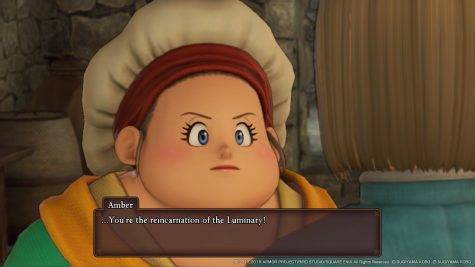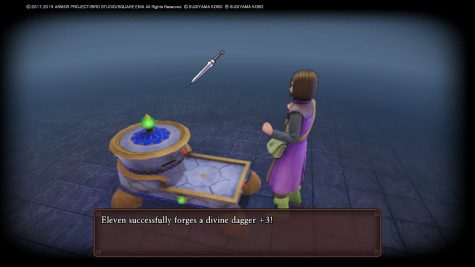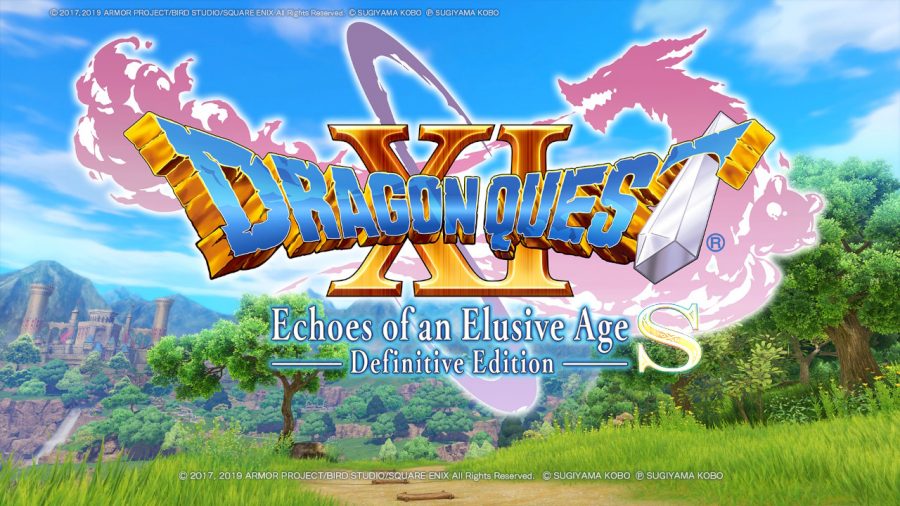A hidden gem: “Dragon Quest XI S” review
More than a year after the Nintendo Switch’s launch of the game, WSS staffer Carter McLaughlin ’23 reviews the definitive edition of “Dragon Quest XI S: Echoes of an Elusive Age.”
The main title screen of “Dragon Quest XI S: Echoes of an Elusive Age – Definitive Edition.”
While other Japanese series like “Pokémon” and “Kingdom Hearts” have gained immense popularity in the western world, the “Dragon Quest” series isn’t one that is well known. The average gamer may have heard the name once or twice, but I never knew anything about the series until recently.
On July 30, 2019, a new purchasable fighter was released for “Super Smash Bros. Ultimate.” This new fighter was labeled as ‘Hero,’ being a culmination of four different Dragon Quest protagonists. This was my first exposure to the series.
Since then, I bought “Dragon Quest XI S: Echoes of an Elusive Age – Definitive Edition” for the Nintendo Switch. With the game’s release on Dec. 4 for the PC, Xbox One, and Playstation 4, I wanted to share my thoughts on the game.
Story
Each game in the series follows the same general principle and concept for their story. The player experiences the game through the eyes of a chosen one, who is prophesied to stop an evil being that either wants to take over or destroy the world.
This game is set in the fantastical world of Erdrea, where it starts with the protagonist who lives in a quiet country village called Cobblestone. He and his childhood friend, Gemma, must climb the Cobblestone Tor as a rite of passage into adulthood.
When at the peak, the two are attacked by a giant, monstrous bird. As the hero is trying to save Gemma, clinging onto the cliffside for her life, the mark on his hand glows. Lightning shortly appeared from the sky, striking the bird, and saving the two.

Upon returning, the hero explained what happened on the tor and was told of his heritage; he is the reincarnation of the Luminary, a legendary figure of the past who saved the world once before. With his newly obtained knowledge, the hero sets out to the prosperous kingdom of Heliodor to speak to King Carnelian.
When meeting Carnelian, the hero was sent to be locked away in the deepest part of the dungeons. Carnelian labels the hero as the ‘Darkspawn,’ as the resurrection of the Luminary also means the ‘Dark One’ will be reborn to once again attempt to destroy all of Erdrea.
Now as a fugitive, the hero has to go on a quest across the vast expanses of the world, bringing together a group of companions, finding the real threat that wants to cause calamity, and figuring out how to prevent the destruction of their world.
Past the summary of the game, without giving away spoilers, I absolutely love the story of it. I’d have to say the writing is phenomenal, both the story itself and even the non-player characters, NPCs, the player can meet along the way. The NPCs of each area have diverse speech patterns, and some may even use words from languages besides the language chosen.
The story gave me a wide array of emotions throughout. I could go from laughing because of the witty dialogue to having chills caused by ominous scenes, and each time it made it harder for me to put the game down. Score: 10/10
Gameplay
The gameplay follows a very similar format to other roleplaying games, RPGs, such as classics like the older “Final Fantasy” games as well as newer games like “Persona 5.” Combat is done in a turn-based style, where each enemy and party member gets a turn to attack.
What makes this game different from other games in the series is that it introduced a new mechanic to the battle system: ‘pep.’ When a character becomes pepped up, specific stats based on the character are boosted and it’s also possible to use ‘pep powers’ when certain conditions are met. I think the mechanic has a charm to it and I really enjoy watching the animations for pep powers.
Once a character gets enough experience, they level up like in a traditional RPG. One thing that’s different from other RPGs is that characters also gain SP, or skill points, that can be used in the character builder to have characters learn new skills. This gives the player a choice on how they want to use a character, whether they want to focus on general abilities or give them skills based on the weapon they wield.

When exploring, players also have many conveniences, for example, the ‘Fun-Size Forge’ allows players to craft items anywhere by playing a minigame. There’s also the ‘horse hailer,’ for use outside of towns, and the spell ‘Zoom’ that both allow for much faster travel than running.
Exploration is heavily encouraged within the game. Many secrets could be easily missed if the player doesn’t check everywhere. These items can be found in many forms, such as a crafting recipe for forging in a book or even equipment, gold, and anything in between hiding inside closets or chests.
I enjoy most aspects of the gameplay, but I found some encounters to be mindless, having me fight enemies while paying little attention because they weren’t strong enough for me to bother using spells or abilities.
Other than some random enemy encounters, I found the rest to be really fun. Boss fights seemed difficult enough that they gave a fair challenge, and I never saw myself needing to grind enemies for level-ups before any huge fights. Score: 9/10
Presentation
The world and characters of the game are great in my honest opinion. The character designer of the game is Akira Toriyama, who is the artist for the Dragon Ball series and is also the character designer for “Chrono Trigger,” a classic RPG. His designs make me like the visuals of the game that much more.
Outside of characters, I’d have to say this game has some of the better visuals on the Nintendo Switch. I found it to be a very beautiful world to explore, whether it was on handheld mode or on the TV.
Before the release of the game for other consoles, people felt lenient on getting a port of a Switch game, expecting it to have the same graphics. This isn’t the case, as seen on a Twitter post by user komodoxeno. They explained that the other versions of the game restore the high resolution of the textures, but kept them merged like in the Switch version.
Here’s the honest difference in character textures between the original PC version of DQXI (left), the Switch Definitive Edition (middle-right), and the PC Definitive Edition (right). Hopefully twitter doesn’t compress this too much ^.^~ pic.twitter.com/pl5mJzAxWb
— lloyd (komodo) ??????? (@komodoxeno) November 5, 2020
The music of the definitive edition is fully orchestrated and sounds great. I found myself enjoying most of the tracks when they were on. The definitive edition also contains synthesized music from the other versions, but many people agree that symphonic music is much better. Some songs, such as the normal battle theme, became repetitive and made me feel there was a lack of variety.
A fully 2D mode was included in the definitive edition, which makes all encounters random. It also changes the cutscenes and music, making them more retro using only text rather than voice acting. A 2D mode is a nice touch for the nostalgia factor, but I wouldn’t recommend it for a first playthrough for the lack of voice acting alone.
The voice acting had so much life to it. I found all the characters to have a fitting and incredible voice acting for cutscenes. I have to give props to Shai Matheson, the voice of Sylvando, because of his amazing performance and his wide range of emotions for the character. Score: 8/10
Overall
From my experience, I found the game to be wonderful. I would easily recommend this to anyone who is interested. For those who have the original version, it’s up to them to decide. It may be more fun with the extras and improvements, but most of the game will be similar to the original.
If nothing else, I strongly recommend for everyone to at least try the demo of the game. It’s free and the developers stated that it’s ten hours long. I found it to only be around eight hours, but that’s still probably the longest demo I’ve played. If someone wants to buy it after enjoying the demo, the data can be transferred to the full game to continue where they left off.
Overall Score: 9/10
Your donation will support the student journalists of West High School. Your contribution will allow us to purchase Scholarship Yearbooks, newsroom equipment and cover our annual website hosting costs.

Carter McLaughlin is a sophomore at West High. This is his first year as an online staff reporter. In his free time, you can expect him to be on his Nintendo...



